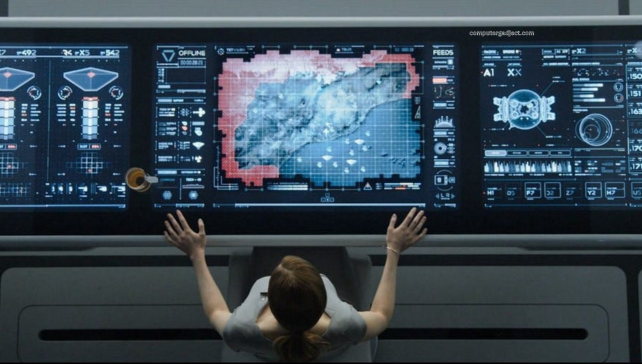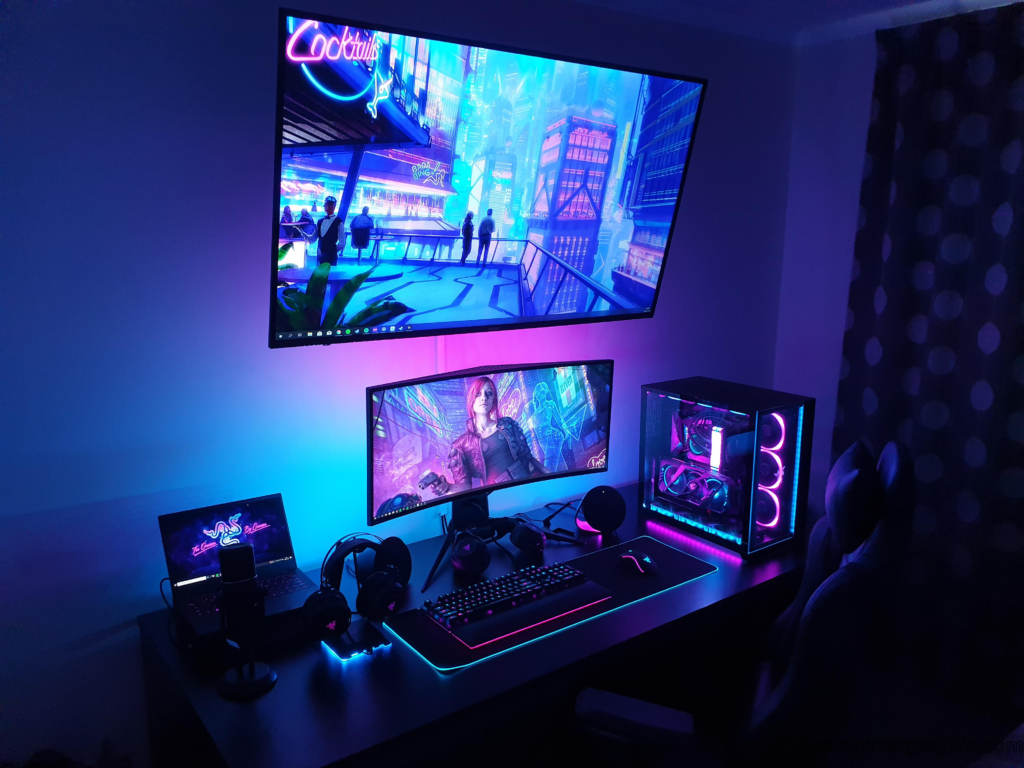A computer screen SVG is an image file format used for vector graphics on a computer screen. This file format is scalable and doesn’t lose its quality when resized.
Computer screens have become an essential aspect of modern technology, allowing people to access information and entertainment in a visual interface. For designers, computer screens serve as a canvas to illustrate their creative ideas, and computer screen SVGs are one of the popular formats used to store vector graphics that can be easily resized.
An SVG or scalable vector graphic is a file format that uses XML to describe the 2D graphics of the image. It is resolution-independent, allowing for scaling without losing quality, which is essential for responsive web design. Additionally, SVGs have small file sizes, resulting in faster loading times. As such, they are a valuable tool for website developers looking to optimize website speed, performance, and search engine optimization.
The Importance Of An Eye-catching Website
An eye-catching website is crucial in today’s digital age. With high competition and Internet users’ short attention spans, a visually appealing computer screen can make all the difference in attracting and retaining visitors. A well-designed website reflects a company’s professionalism and can increase credibility and customer engagement.
Why A Good Website Matters
As the world becomes more digital, having an attractive website becomes increasingly important. It is usually the first point of contact between a company and its potential customers. A good website can leave a lasting impression, influencing a person’s decision to join a company. Conversely, a poorly designed or outdated website can put you off and cause potential customers to look elsewhere.
The Role Of Web Design In Attracting Traffic
Web design plays a crucial role in attracting traffic to a website. This includes layout, color scheme, typography, and overall visual appeal. A well-designed website can create a positive user experience by making it easier for visitors to find what they are looking for and navigate the site. It can also help establish credibility and build trust with potential clients. To ensure a website is visually appealing and easy to use, working with a trained web designer who understands the importance of web design and its role in providing a great user experience is essential.
Additionally, incorporating relevant and engaging content and optimizing the website for search engines can generate traffic and increase conversions. In conclusion, having an attractive website is essential in today’s digital age, and the role of web design in attracting traffic cannot be underestimated. Businesses can establish credibility and increase engagement with potential customers by working with a skilled web designer and optimizing the user experience.
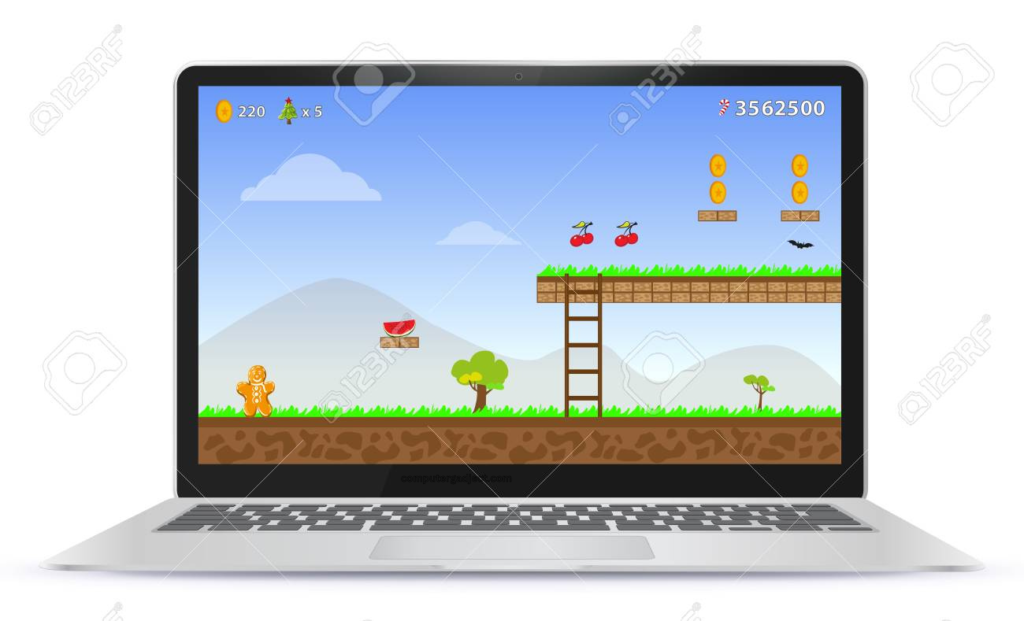
The Rise Of Svgs
SVGs are quickly gaining popularity because they can be scaled to any size without losing clarity or resolution. Using SVG on computer screens ensures sharp images and faster loading speeds, making them popular for web designers.
The Emergence Of Scalable Vector Graphics
Scalable vector graphics (SVG) have been around for quite some time, but they have only gained popularity in recent years in web design. Traditionally, raster images such as JPEG and PNG have dominated the digital landscape. Still, SVGs offer a variety of benefits that have made them the preferred choice for designers and developers.
Benefits Of Using Svgs In Web Design
Using SVG in web design has several benefits: they are scalable, lightweight, and versatile, to name just a few. These are some of the key advantages:
- Scalability: Unlike raster images, SVGs are vector-based, which can be scaled up or down without losing quality or clarity. This makes them ideal for responsive design and high-resolution displays.
- Small File Size: SVGs are typically much smaller in file size than raster images, which means they load faster and use up less bandwidth. This is particularly important for users on slower connections or mobile devices.
- Animation: SVGs can be animated using CSS or JavaScript, allowing for more dynamic and engaging designs.
- Accessibility: SVGs are accessible to users with visual impairments, as they can be scaled up without losing clarity. This makes them ideal for icons, logos, and other design elements.
Overall, the rise of SVGs has been a game-changer in web design, offering designers and developers a variety of benefits and possibilities. As web technologies evolve, SVGs will likely become an even more essential tool in any designer’s toolkit.
Understanding Computer Screen Svgs
Computer Screen SVGs are vector graphics used as images in web design. They are created in scalable vector format and can be easily resized without losing quality. Understanding how to use them can improve the appeal and functionality of a website.
What Are Computer Screen Svgs?
Computer screens are essential components of modern computing systems. They are the interface that allows users to interact with graphical user interfaces (GUI) and displays visual information generated by a computer. Scalable vector graphics (SVG) are special file formats that allow us to display graphics on a web page or computer screen and have revolutionized how we display and communicate visual information. But what are computer screen SVGs?
Features Of Computer Screen Svgs
- Easy to scale: SVGs are vector-based, meaning the images can be scaled to any size without losing quality.
- Small file size: SVG files have much smaller file sizes than other image file formats like JPEG or PNG. This makes them ideal for web use where load times are critical.
- Resolution independent: SVGs are resolution independent, meaning they can be displayed on any screen size or resolution and still look great.
- Easy to animate: SVGs allow for easy animations without complex scripting or programming.
- Accessibility: SVGs are accessible and can be read by screen readers, which makes them ideal for use in web applications that require accessibility compliance.
If you’re a web designer or developer, understanding computer screen SVGs is essential. They offer many benefits over traditional image file formats and are becoming increasingly popular online. For example, they are ideal for responsive web design, where images must be dynamically enlarged or reduced to fit different screen sizes. They are also perfect for developing games, animations and other interactive web-based graphic content.
Overall, computer screen SVGs are a versatile and powerful way to display graphics on a computer screen or web page. Now that you better understand what they are and why they are so popular, you can start exploring how to use them to improve your web projects.
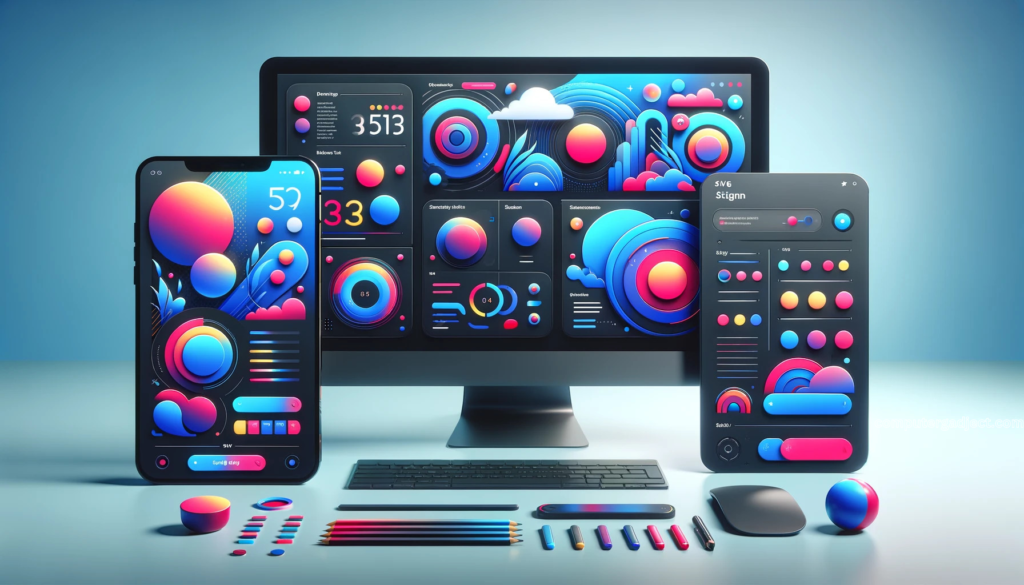
How To Revamp Your Website With Computer Screen Svgs
Revamping your website with computer screen SVG is a great way to improve its visual appeal. These versatile graphics can add a modern, high-tech feel to your design. With computer screen SVGs, you can create attractive images that are informative and aesthetically pleasing to users.
Are you looking for a creative way to revamp your website and make it visually pleasing for your audience? Look no further than incorporating computer screen SVG into your design. Computer Screen SVGs are scalable vector graphics that present your website content in a modern and dynamic way. This post will explore the key steps to integrate computer screen SVGs into your website design.
Assessing Your Current Website
The first step to revamping your website with computer screen SVG is to evaluate it. Identify areas that need improvement. Check if the website has a complex design, unattractive colors, or outdated images. Also, consider your website’s loading speed and user experience. Knowing where you need to improve your website will help you identify the sections that require the SVG design element and will also enhance the user experience of your website.
Incorporating Computer Screen Svgs Into Your Design
Once you’ve identified areas on your website that need improvement, you can incorporate computer screen SVGs into your design. Here are some ways to add computer screen SVG to your website:
- Place them in the header and footer sections of your website to grab visitors’ attention
- Use them to add a creative touch to landing pages or sections with call-to-action buttons
- Use them to create site menus or backgrounds with corresponding images
- Design your website with SVG animation for a more interactive experience
Best Practices For Using Computer Screen Svgs
When using Computer Screen SVGs, here are some best practices you should follow:
- Use SVGs that are minimalistic and don’t clutter your website’s design
- Ensure the SVGs are compatible with different browsers and devices
- Optimize the SVGs for use on your website to minimize site load times
- Use high-quality graphics to ensure your website looks professional and attractive
- Place the SVGs in appropriate sections of your website to enhance the user experience
Revamping your website with Computer Screen SVG is an effective way to attract and retain visitors. Following the steps outlined above and incorporating best practices, you can take your website design to new heights and provide a more engaging user experience.
Examples Of Websites Using Computer Screen Svgs
Websites like InVision and Figma use computer screen SVGs to create attractive user interfaces. These SVGs help designers add realistic-looking devices to their designs.
Case Studies On Websites That Utilize Computer Screen Svgs
Computer screen SVGs are becoming increasingly popular among website designers. This is because they provide a simple and creative solution for displaying computer-related content or illustrating the digital world. Many websites have adopted this concept and use computer screen SVGs differently. Let’s look at case studies on websites using computer screen SVGs effectively.
Case Study 1: Dropbox Paper
Dropbox Paper is one of the most innovative websites that use computer screen SVG. This website features a virtual document editing interface, and the SVGs on your computer screen simulate the actual screen during the editing process. There is an SVG computer screen located on the left side of the document, showing the document’s content as it would appear on a computer screen. The SVG computer screen is interactive, and users can easily navigate the document.
Case Study 2: Marvel App
Marvel App is another website that uses computer screen SVGs to showcase its product features. The Marvel app computer screen SVG allows users to view the software’s interactive demos. The design and layout of the screen mimic an actual device, making it easy to show how the software will appear on an actual device.
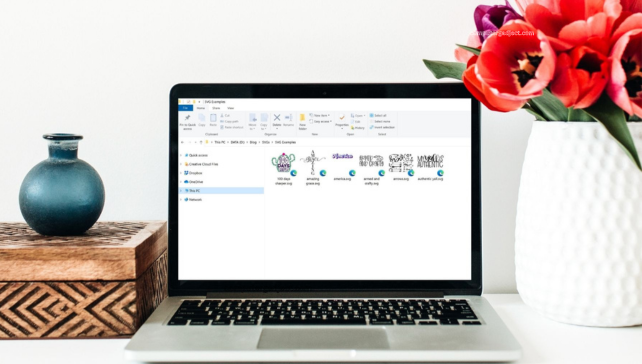
Inspiration From Websites With Creative Computer Screen Svg Designs
Example 1: Slack
Slack is a platform that uses computer screen SVGs to display platform features. Slack Computer Screen SVGs are creative and innovative. They simulate a computer screen, and their layouts perfectly mimic what Slack looks like on a real device. The SVG computer screen shows the Slack messaging interface, making it easy for users to imagine using a real device.
Example 2: Dribbble
Dribbble is another website that uses computer screen SVGs effectively. Dribbble Computer Screen SVGs simulate a computer screen, showcasing Dribbble designs and concepts, making it easy for users to visualize the designs on an actual device. The SVG computer screen is interactive, and users can easily navigate through the designs and concepts displayed on the platform. In conclusion, computer screen SVGs are a creative solution for displaying computer-related content or illustrating the digital world. Many websites have adopted this concept to showcase their features creatively. The case studies and examples above inspire how to effectively use computer screen SVGs on a website.
Tools For Designing And Implementing Computer Screen Svgs
Designing and implementing computer screen SVGs can be easy with the right tools. Fortunately, several solutions, including Figma, Sketch, and Adobe Illustrator, can help you streamline the process and produce high-quality graphics.
If you’re looking for ways to improve the user experience on your website, using computer screen SVG is a great option. Unlike traditional images, SVGs are vector-based, making them easily scalable without losing quality. Tools for designing and implementing computer screen SVGs vary in complexity, and some require technical expertise. However, there are many easy-to-use tools that even beginners can use effectively. In this article, we’ll explore popular design tools and techniques you can use to implement computer screen SVG on your website.
Popular Designing Tools For Computer Screen Svgs
Several tools are available when designing SVGs for computer screens, ranging from free to paid. Here are some popular ones:
Designing Tools
Features
Inkscape
Free; open-source; easy to use; compatible with multiple platforms; supports various formats.
Adobe Illustrator
Paid; industry-standard tool; supports various formats; allows for complex designing.
Sketch
Paid; designed specifically for macOS; offers vector editing and prototyping; allows for exporting SVGs.
How To Implement Computer Screen Svgs On Your Website
Implementing computer screen SVGs into your website may seem challenging, but it’s relatively simple, and there are many approaches you can take. Here are some general techniques:
- Create SVG with an editor: Design and edit SVGs with popular editor tools such as Adobe Illustrator, Sketch, and Inkscape.
- Use inline SVGs: Use inline SVGs directly in your HTML code.
- Use SVG sprites: Combine multiple SVGs into a single file, reducing HTTP requests and speeding up load times.
- Use script-based SVGs: Create SVGs with the help of scripts such as Snap.svg, Vivus, and Greensock.
- Use CSS-based SVGs: Style and animate SVGs using CSS properties.
In conclusion, designing and implementing SVG on computer screens can seem intimidating. However, anyone can do it by using the right tools and techniques. Following the guidelines outlined in this article, you can improve your website’s user experience and create attractive images that load quickly and look great on any device.
Frequently Asked Questions For Computer Screen Svg
What Is A Computer Screen Svg?
A computer screen SVG is a vector graphics file format that can be edited and scaled without losing resolution. It is commonly used for web design and can help sites load faster and look better on different devices.
Why Use A Computer Screen Svg?
Using an SVG on a computer screen can help improve website loading times as it is a smaller file size than other image formats. Additionally, SVGs are scalable and efficiently edited, making them the preferred choice for graphics and web design.
How Do I Create A Computer Screen Svg?
Several ways exist to create an SVG computer screen, including vector software like Adobe Illustrator or Inkscape. You can also convert existing image files to SVG format using online conversion tools.
Can I use a computer screen screen on any website?
Computer Screen SVGs are compatible with all modern web browsers and can be used on any website. They can help improve website performance and improve user experience.
Conclusion
In short, Computer Screen SVG is a valuable tool for designers, developers, and website builders. It allows them to create high-quality, visually appealing designs cost-effectively. Because SVG files are scalable and easily manipulated, so they offer more design flexibility than traditional image formats.
With benefits like speed, responsiveness, and reduced file size, SVGs are clearly the way of the future. Incorporating them into your design workflow will give you an advantage in today’s technology landscape.

